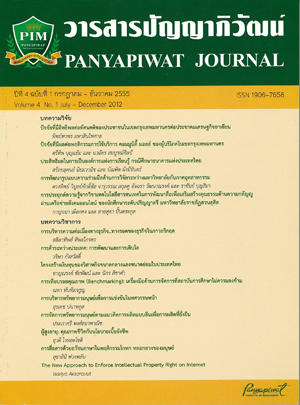การบริหารความต่อเนื่องทางธุรกิจ ทางรอดของธุรกิจในภาวะวิกฤก
Main Article Content
บทคัดย่อ
การบริหารความต่อเนื่องทางธุรกิจ (Business Continuity Management : BCM) นับว่าเป็นทางออกสำหรับการลดความเสียหายที่เกิดขึ้นจากกระบวนการดำเนินงานหยุดชะงัก เมื่อเกิดภาวะวิกฤตต่างๆ ขึ้น โดยธุรกิจจะต้องกำหนดกลยุทธ์และแนวทางในการปฏิบัติงานเพื่อให้องค์กรสามารถดำเนินงานได้อย่างต่อเนื่อง แม้ในภาวะวิกฤต ทั้งในด้านการวางแผนก่อนเกิดเหตุการณ์ การดำเนินการตามระยะเวลาที่กำหนดในขณะเกิดเหตุการณ์ และการฟื้นฟูเมื่อสถานการณ์เริ่มคลี่คลาย ทั้งนี้ก็เพื่อให้การบริหารงานเกิดความต่อเนื่อง ไม่หยุดชะงัก หรือหากหยุดชะงักก็สามารถกลับมาดำเนินการได้อย่างรวดเร็วที่สุด อีกทั้งยังต้องรักษาภาพลักษณ์ของตราสินค้าและองค์กรควบคู่ไปด้วย แต่การจะดำเนินการให้บรรลุผลนั้นก็ต้องอาศัยความร่วมมือจากผู้ที่มีส่วนเกี่ยวข้องทั้งภายในและภายนอกองค์กร
Business Continuity Management (BCM) is one of the key solutions to minimize the impact of sudden stop in operation process under a crisis situation. Businesses have to specify certain strategies and operational procedures implementing before, during and after the crisis in order to maintain continuingly normal operation, or in the worst case, to recover back from crisis as soon as they can. Moreover, BCM can help businesses to maintain positive brand image and stimulate corporate reputation. However, businesses cannot have a successful BCM without any help and support from both internal and external stakeholders.
Article Details
“ข้าพเจ้าและผู้เขียนร่วม (ถ้ามี) ขอรับรองว่า บทความที่เสนอมานี้ยังไม่เคยได้รับการตีพิมพ์และไม่ได้อยู่ระหว่างกระบวนการพิจารณาลงตีพิมพ์ในวารสารหรือแหล่งเผยแพร่อื่นใด ข้าพเจ้าและผู้เขียนร่วมยอมรับหลักเกณฑ์การพิจารณาต้นฉบับ ทั้งยินยอมให้กองบรรณาธิการมีสิทธิ์พิจารณาและตรวจแก้ต้นฉบับได้ตามที่เห็นสมควร พร้อมนี้ขอมอบลิขสิทธิ์บทความที่ได้รับการตีพิมพ์ให้แก่สถาบันการจัดการปัญญาภิวัฒน์หากมีการฟ้องร้องเรื่องการละเมิดลิขสิทธิ์เกี่ยวกับภาพ กราฟ ข้อความส่วนใดส่วนหนึ่งและ/หรือข้อคิดเห็นที่ปรากฏในบทความข้าพเจ้าและผู้เขียนร่วมยินยอมรับผิดชอบแต่เพียงฝ่ายเดียว”
เอกสารอ้างอิง
กรมป้องกันและบรรเทาสาธารณภัย. (2550). โครงการจัดทําแผนแม่บทป้องกันและบรรเทาภัยจากคลื่นสนามิ, กรุงเทพฯ: กรมฯ.
กรุงเทพธุรกิจ. (2554, 26 พฤศจิกายน), น้ําท่วม!ทําเศรษฐกิจไทยเสียหาย 1.4 ล้านล้าน. กรุงเทพ ธุรกิจ, 4.
กรุงเทพธุรกิจ. (2554, 16 ธันวาคม), การบริหารความต่อเนื่องทางธุรกิจในกิจการการผลิตและห่วงโซ่อุปทาน. กรุงเทพธุรกิจ, 11.
สํานักงานมาตรฐานผลิตภัณฑ์อุตสาหกรรม. (2552,11-13 พฤษภาคม), ไขรหัส BCM (2), ประชาชาติ ธุรกิจ, 29.
สํานักงานเศรษฐกิจการคลัง สํานักนโยบายเศรษฐกิจมหาภาค . (2554). บทวิเคราะห์เรื่อง ฝ่ามหาอุทกภัยปี 2554. กรุงเทพฯ : สำนักงานฯ.
Business Continuity Institute. (2002). BCM: A Strategy for business survival. Worcester: BCI.
Elliot, D. S. (2002). Business Continuity Management: A Crisis Management Approach.London : Routledge.
Fink, S. (1986). Crisis Management: Planning for the Inevitable. New York: American Management Association.
Gibb, F. & Steven, B. (2006). A framework for business continuity management. International Journal of Information Management, 26, 128-141
Low, S. P., Liu, J. & Sio, S. (2010). Business continuity management in large construction companies in Singapore. Disaster Prevention and Management, 19(2), 219-232.
Mitroff, I.A. (2003). Preparing for evil. Harvard Business Review, 109-15.
O'Hehir, M. (2001). Effective risk management and BCP drivers. In A. Hiles, & P. Barnes (Eds.), The Definitive Handbook of Business Continuity Management (pp. 25-42). Chichester: Wiley.
United Nations. International Strategy for Disaster Reduction. (2007). Disaster Risk Reduction: 2007. Geneva: UN.
Vancoppenolle, G. (2001). What are we planning for? In A. Hiles, & P. Barnes (Eds.), The Definitive Handbook of Business Continuity Management (pp. 3-24). Chichester: Wiley.


